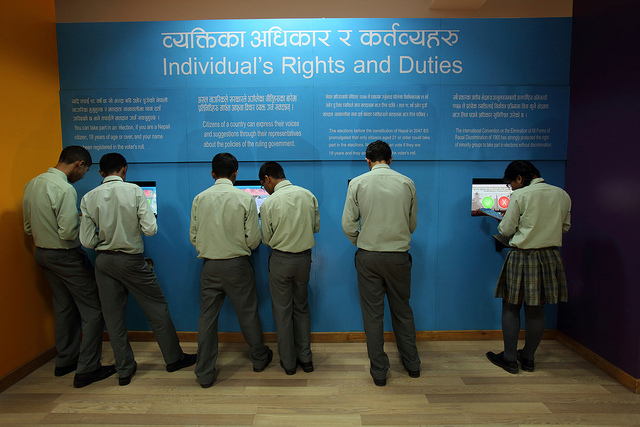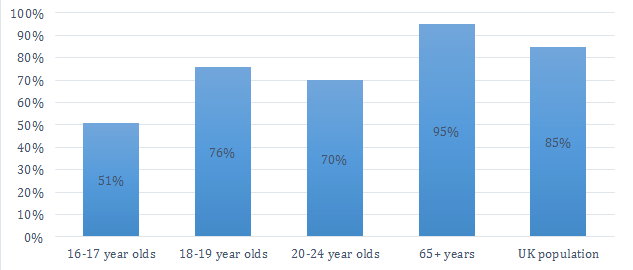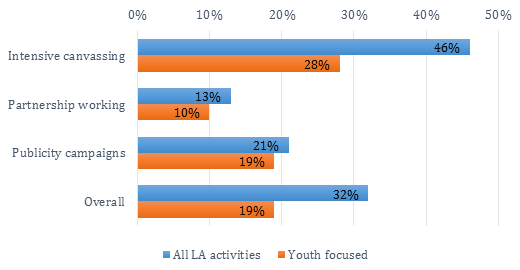If Local Authorities are to succeed in increasing voter registration amongst young people, they must make use of direct recruitment
We are seeing increasing attention given to the issue of young people’s electoral participation. Electoral registration, the first step in the voting process, is one area in which activities to encourage a more electorally active youth might be targeted. Using data and feedback from a Cabinet Office evaluation of local authority activities aimed at maximising registration, Charlotte Snelling, explores how the lessons learnt might be applied to young people. She argues that while it is important to continue developing innovative methods of engagement, direct recruitment remains a significant factor in determining whether an individual becomes active or not.
The electoral turnout of young people in the UK is the lowest of any group in the electorate – just 44 per cent of 18-24 year olds in the 2010 General Election, versus the 65 per cent average. Youth turnout is also falling at a far faster rate than for any other group. In response, work is ongoing to understand why youth turnout is so low, and to explore what might be done to invigorate it. In 2014 we have seen the launch of the UK’s League of Young Voters, a coalition of organisations aiming to raise young people’s participation in elections. Meanwhile, the UK Political Studies Association Youth Politics Group report ‘Beyond the Youth Citizenship Commission’ has brought together academics to explore political barriers faced by young people, and suggested ways of overcoming them.
Other research suggests that societal modernisation and increasing education are leading young people to develop alternative political preferences. There is reason to believe today’s young people can be discouraged by traditional, bureaucratic, formal, and hierarchical procedures – instead, the theory goes, they will respond more positively to less overtly political interventions. This implies that there is a need for rethinking the ways in which young people have been historically targeted by political groups.
Whilst, understandably, much attention focuses on ‘getting out the vote’, there is growing recognition that electoral registration is an important issue. In the UK, electoral registration is a necessary precursor to voting. As it is not automatically ensured by the state, it can present a hurdle to becoming electorally active – particularly for young people. Compared to the 85% national registration rate, current Electoral Commission estimates suggest young people are under-registered. As such, any attempt to inspire a young person to vote must also look to encourage and support their registration.
Figure 1: Electoral Commission (2014) electoral registration completeness rates
Source: Electoral Commission, The (2014) The quality of the 2014 electoral registers in Great Britain. London. The Electoral Commission
Maximising registration: local authority activities
In September 2014, The Cabinet Office published an evaluation of activities it has funded to maximise registration among under-registered groups in Local Authorities (LAs) – including social and private renters and young people. This (and the data presented alongside it) can contribute to our thinking about how we might better engage young people in electoral registration. The activities pursued by LAs fell into three categories:
- Intensive canvassing – a targeted extension of annual canvass activity designed to identify and personally contact unregistered voters through additional mail-outs and doorstop visits.
- Partnership work – using partners both within and external to the council (for example, council youth services, housing associations) to disseminate resources and deliver programmes.
- Publicity campaigns – communications-based activities led by the council and delivered through digital, social, and press media channels, as well as face-to-face outreach.
The first of these closely relates to LAs’ existing work in the annual household canvass and against which they are annually assessed (within the Electoral Commission’s Performance Standards). The second and third methods provide examples of activities which are arguably more detached from formal electoral politics and administration.
Young people were targeted in 13 of the 24 LAs, variously defined as attainers (16-17 year olds), 18-24 year olds, and students. In six cases, two of each activity type, young people were the sole focus. Whilst studying only these is not ideal (lack of standardization and small sample size), by comparing these particular LA results to the evaluation as a whole we can start to explore some of the assumptions about increasing youth participation.
The evaluation found that intensive canvassing was the most successful in converting a targeted non-registered elector into a new registration (Figure 2). This supports the maintaining of the household canvass under Individual Electoral Registration (introduced in 2014), and suggests that additional canvassing targeted at under-registered groups can be effective in encouraging registrations. On average, almost half of the electors targeted by these activities were registered by the end of the activity period. Interestingly, however, the same was true of those targeting young people – where 28% of target registrations were achieved. This runs contrary to present thinking: that what works for older people does not necessarily work for young people.
Figure 2: Maximising registration success rates
While further examination of these six youth activities find the most successful to have been a publicity campaign (35%), it is notable that a major component of this was a student ‘mail drop’ akin to canvassing. This LA’s experiences led them to report:
‘Social media does not make the topic of registering to vote any more appealing. Direct contact with URGs [Under-registered groups] elicits the best response, be that direct mail or direct email.’ (Welsh county council).
Despite the small sample size, the evaluation data and feedback suggests that direct recruitment remains crucial in encouraging a young person to register to vote. Intensive canvassing, although perhaps not the most innovative technique, still appears successful in converting casual interest into actual registrations. Local data matching, for example, offers the potential for direct and personalised communication to those individuals who need it most: the unregistered. Publicity and partnership campaigns, by contrast, place more onus on the individual to be aware and become active – the individuals most likely to engage in a social media campaign or attend outreach events are often those who are already likely to be political. What this evaluation has shown is that, in many cases, the most important thing in deciding whether a young person registers is simply whether they are asked to. We should not therefore automatically reject traditional canvassing.
Still, success rates were far lower among young people than other under-registered groups, and the evaluation reports useful lessons from all three activity types. Youth-focused intensive canvassing might thus be improved further by referring to the experiences of the publicity and partnership LAs. This could include peer-to-peer delivery (for example, extending this partnership practice to see students canvassing student housing), increased market research into the design of materials sent to young people, and the use of tablet technology when doorstep canvassing. Finance permitting LAs might also want to think about delivering publicity and/or partnership activities in tandem with a more traditional canvass so as to reinforce its effectiveness.
Given methodological limitations, this evaluation clearly does not provide overwhelming support for any one approach when applied to young people. What can be seen, however, is that if LA’s registration activities are to succeed, then direct recruitment should feature heavily.
—
Note: this post represents the views of the author alone and not those of Democratic Audit or the LSE,or any other organisation or organisations involved in the research. Please read our comments policy before posting.
This post is part of a series on youth participation based on the Political Studies Association project, Beyond the Youth Citizenship Commission. For further details, please contact Dr Andy Mycock. An electronic copy of the Beyond the Youth Citizenship Commission: Young People and Politics volume can be downloaded here.
—
 Charlotte Snelling is an ESRC-funded postgraduate research student at the University of Edinburgh. Her PhD research focuses on young people’s electoral turnout, in particular the combined effects of age and education in shaping the participation opportunities encountered by students and non-students, how these shape their attitudes towards politics, and in turn, the participation activities they engage in. She utilises primarily quantitative methods and tutors on social statistics courses to both undergraduates and postgraduates at the University of Edinburgh. She writes here in a personal capacity.
Charlotte Snelling is an ESRC-funded postgraduate research student at the University of Edinburgh. Her PhD research focuses on young people’s electoral turnout, in particular the combined effects of age and education in shaping the participation opportunities encountered by students and non-students, how these shape their attitudes towards politics, and in turn, the participation activities they engage in. She utilises primarily quantitative methods and tutors on social statistics courses to both undergraduates and postgraduates at the University of Edinburgh. She writes here in a personal capacity.








 Democratic Audit's core funding is provided by the Joseph Rowntree Charitable Trust. Additional funding is provided by the London School of Economics.
Democratic Audit's core funding is provided by the Joseph Rowntree Charitable Trust. Additional funding is provided by the London School of Economics.
Surely, the whole issue of ‘registration’ is a spurious issue.
Every UK citizen is already ‘registered’ with HMRC (for benefits and/or taxation purposes). That ‘registration’ includes NINO, DOB and current address. Just scrap all local authority ‘registers’, take a single national copy of the DWP/HMRC data, sort it to current address, and problem solved – 100% ‘registration’.
Then we could all focus on the real and fundamental issue – implementing proportional representation so that it would be worth voting.
Why are all the supposed ‘experts’ so determined to chase their own tails on the spurious ‘registration’ issue?
If LAs are to succeed in increasing voter registration amongst young people, they must make use of direct recruitment https://t.co/1DCZNgzQSW
If Local Authorities are to boost voter registration amongst young people, they must make use of direct recruitment https://t.co/6JhLZ2n4Mr
See my blog post @democraticaudit on electoral registration, young people, and recruitment: https://t.co/YDOZFIiLrJ
If councils are to succeed in increasing voter reg amongst young people they must make use of direct recruitment https://t.co/Q9O0xp5Mj3
If Local Authorities are to succeed in increasing voter registration amongst young people, they must make use of… https://t.co/bVz3iMAAxb